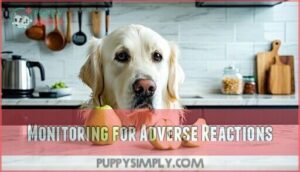This site is supported by our readers. We may earn a commission, at no cost to you, if you purchase through links.

Remove all seeds and the core first – they contain compounds that aren’t safe for your pup. The flesh provides vitamin C, fiber, and antioxidants that support your dog’s immune system.
Start with small pieces to see how your furry friend handles this sweet fruit. Like any treat, moderation matters since pears contain natural sugars that can cause tummy troubles if overdone.
Wash the pear thoroughly and cut it into bite-sized pieces appropriate for your dog’s size. There’s more to know about serving sizes and potential red flags.
Table Of Contents
- Key Takeaways
- Dogs Eating Pears Safely
- Can Dogs Eat Pears
- Pear Nutrition Facts
- Feeding Pears to Dogs
- Risks of Pear Consumption
- Safe Pear Serving Methods
- Pear Allergies and Intolerances
- Healthy Alternatives to Pears
- Veterinary Guidance and Pears
- Frequently Asked Questions (FAQs)
- Can dogs eat pears with skin?
- Are pears toxic to dogs?
- What fruit is not good for dogs?
- What is the healthiest fruit for dogs?
- Is it safe to give my dog canned pears?
- Are there any special precautions I should take when feeding pears to dogs?
- Are pears safe for dogs with diabetes?
- Can I grow my own pears for my dog?
- Is there a way to make pear treats for my dog?
- Can puppies eat pears at what age?
- Conclusion
Key Takeaways
- Remove all seeds and cores before serving – Pear seeds contain cyanide compounds that can poison your dog, and cores create choking hazards that require emergency surgery.
- Start with small portions and monitor reactions – Limit pear treats to 10% of your dog’s daily calories, cut into bite-sized pieces appropriate for your dog’s size, and watch for digestive upset or allergic reactions.
- Choose fresh, ripe pears and wash thoroughly – Fresh pears provide the best nutrition and digestibility, while washing removes harmful pesticides and chemicals from the skin.
- Consult your vet for dogs with health conditions – Dogs with diabetes, kidney disease, or sensitive stomachs need special consideration due to pears’ sugar content and fiber, making professional guidance essential.
Dogs Eating Pears Safely
Pears can be a healthy treat for your dog when you prepare and serve them correctly.
You’ll need to remove the seeds and core, cut the fruit into small pieces, and limit portions to prevent digestive upset, which is a complete concept in dog care.
Nutritional Benefits of Pears
Pears pack impressive nutritional value for your dog’s health.
These juicy fruits deliver essential Vitamin Content including vitamin C and A, plus important minerals like potassium.
The Fiber Benefits support healthy digestion, while pears serve as a natural Hydration Source with 84% water content.
Their Antioxidant Power helps combat cellular damage, making pear nutrition dogs can truly benefit from.
Website users can also manage consent preferences for cookies.
Health Benefits for Dogs
Your dog’s body will thank you for adding pears to their treat rotation.
These fruits deliver a vitamin boost with vitamins A and C that strengthen immune function.
The fiber digestion support helps prevent constipation, while antioxidant power fights harmful free radicals.
Pears also provide hydration source benefits and mineral support through potassium, making pear benefits dogs truly remarkable for overall health.
Risks of Overconsumption
While pears offer great benefits, too much of a good thing can spell trouble.
Sugar overload from excessive pear consumption leads to digestive distress, causing upset stomach and diarrhea in your furry friend.
Regular overconsumption creates weight gain and diabetes risk, while natural sugars contribute to dental issues.
Monitor your dog’s pear intake to maintain ideal digestive health.
Can Dogs Eat Pears
Yes, pears are safe for dogs when served properly. Most dog-friendly fruits require careful preparation, and pears are no exception. You can confidently add this nutritious treat to your dog’s diet, but understanding the basics matters.
Feeding dogs pears starts with choosing the right fruit. Organic pears offer the cleanest option, free from harmful pesticides. Pear ripeness plays a vital role – ripe pears are softer and easier to digest. Different pear varieties like Bartlett or Anjou work equally well for canine consumption.
The key concern involves seed toxicity. Pear seeds contain cyanide compounds that pose serious health risks. Always remove seeds and cores before serving. Puppy pears require extra attention due to smaller digestive systems.
Fresh pears provide vitamins, fiber, and antioxidants that benefit your dog’s health. However, moderation remains essential. Too much fruit can upset sensitive stomachs, regardless of the pear’s quality.
Pear Nutrition Facts
Understanding pear nutrition helps you make informed decisions about feeding this fruit to your dog.
Pears contain essential vitamins, minerals, and fiber that can benefit your pet’s health when served properly, which is a key concept in pear nutrition.
Vitamins and Minerals
Rich in essential nutrients, pears pack impressive Vitamin C Benefits that boost your dog’s immune system.
These fruits deliver significant Potassium Levels supporting heart function, plus calcium and magnesium for strong bones.
Dog pear vitamins include vitamin A for eye health and B-complex vitamins for energy metabolism.
To confirm your dog gets the right amount, remember to consult with vets about appropriate supplementation.
The dog pear nutrition profile makes these minerals and vitamins excellent additions to your pup’s diet when served properly.
Fiber and Antioxidants
Your pup’s digestive system will thank you for pears’ impressive fiber content, which promotes healthy bowel movements and supports overall dog digestion.
These fruits pack powerful antioxidants like vitamin C and flavonoids that boost cellular health while reducing inflammation throughout your dog’s body.
This hydrating snack delivers essential pears for dogs benefits, making it a nutritious choice for occasional treats with notable health benefits.
Calorie and Sugar Content
A medium pear packs 101 calories and 14 grams of sugar, making portion control essential for your dog’s weight management.
While pears have a low glycemic index, their sugar impact can affect diabetic dogs substantially.
- Calorie Density: 101 calories per medium pear (178g)
- Dog Pear Sugar: 14g total sugars including fructose and glucose
- Dog Diabetes: Avoid pears for diabetic dogs due to sugar content
- Dog Obesity: Limit portions to prevent weight gain
- Dog Pear Calories: Factor into daily caloric intake calculations
Feeding Pears to Dogs
You can safely feed pears to your dog when you follow proper serving guidelines and preparation methods.
Always remove seeds and cores, cut the fruit into bite-sized pieces, and limit portions to prevent digestive upset or choking hazards.
Serving Size Guidelines
Determining the right pear serving size for your dog requires understanding that breed size matters substantially.
Extra-small dogs need just one or two ½-inch pieces, while small dogs can handle two to three 1-inch pieces.
Remember the daily calorie limit rule: treats shouldn’t exceed 10% of your dog’s total intake.
Monitor stool changes when introducing pears for dogs, adjusting dog pear portion accordingly through careful dietary moderation.
Preparation and Safety Tips
When preparing pears for dogs, proper technique makes all the difference between a safe treat and potential trouble.
Here’s your essential preparation checklist:
- Wash thoroughly to remove pesticides and dirt
- Remove core and all seeds completely
- Cut into bite-sized pieces appropriate for your dog’s size
- Monitor eating to prevent gulping or choking
- Verify freshness matters – only serve ripe, fresh pears
Consider exploring options for specialized dog treat tools to streamline the preparation process.
Monitoring for Adverse Reactions
After serving pears, watch your dog closely for Allergy Symptoms like itching or swelling.
Monitor for Digestive Discomfort, including upset stomach or unusual Stool Changes.
Notice any Behavioral Shifts such as lethargy or restlessness that might signal a dog pear allergy.
If you spot signs of an allergic reaction affecting your dog’s digestive health, schedule a Vet Consultation with your veterinarian immediately.
Risks of Pear Consumption
While pears offer nutritional benefits for your dog, you’ll need to understand the potential risks before serving this fruit.
Pear seeds contain cyanide compounds, and overconsumption can lead to digestive upset, choking hazards, and other health complications that require your attention.
Choking Hazards and Seeds
Pear cores and seeds create serious choking hazards for dogs, especially small dogs and puppies.
Never give whole pears to dogs—cores and seeds are choking hazards that can be deadly.
Core removal prevents gastrointestinal blockages that require emergency surgery.
Seeds pose dual threats—they’re choking risks and contain toxic compounds.
Preventative measures include cutting pears into bite-sized pieces and removing all seeds before serving.
Never give whole pears to prevent dog pear choking incidents, as this can lead to serious health issues due to choking hazards.
Cyanide Poisoning and Symptoms
Several pear seeds can trigger cyanide poisoning in your dog, with toxic levels at roughly 2mg per kilogram of body weight. Even small amounts pose serious dog health risks, making pear toxicity dogs face a genuine concern among toxic foods.
Even a few pear seeds contain enough cyanide to seriously poison your dog – never risk it.
Critical cyanide poisoning symptoms to watch for:
- Bright cherry-red gums – indicating oxygen can’t reach cells properly
- Rapid or labored breathing – as the body struggles for oxygen
- Excessive drooling and salivation – an early warning sign
- Convulsions or seizures – showing severe neurological impact
- Paralysis or collapse – requiring immediate emergency care
This medical emergency demands instant veterinary attention. Call your vet while driving to the hospital so they can prepare sodium nitrite and sodium thiosulfate antidotes. Signs typically appear within 20 minutes to a few hours after consuming pear seeds.
Long-term effects from chronic low-level exposure include joint problems and potential reproductive issues. Don’t underestimate these cyanide sources – even seemingly harmless pear cores contain enough toxicity levels to cause serious harm. Immediate actions save lives when dog pear cyanide poisoning occurs.
Digestive Issues and Allergies
Some dogs experience pear intolerance or fiber sensitivity, leading to digestive upset like diarrhea and gas.
Sugar overload from excessive consumption can cause stomach irritation.
Watch for allergic reactions including itching, vomiting, or swelling after feeding pears.
Gradual introduction helps identify sensitivities early. Monitor your dog’s digestive health closely when introducing this new treat to their diet.
Safe Pear Serving Methods
You can safely serve pears to your dog by following proper preparation methods that eliminate potential hazards.
Always choose fresh, ripe pears, remove all seeds and cores completely, cut the fruit into small bite-sized pieces.
Limit portions to no more than 10% of your dog’s daily food intake, ensuring a safe and healthy treat.
Fresh and Ripe Pears
Always choose fresh, ripe pears for your dog’s safety and digestive health.
Ripe pears offer better nutrition and easier digestion than unripe fruit. Check seasonal availability at local markets for the freshest options.
- Organic pears: Choose pesticide-free varieties when possible for safer dog pear consumption
- Pear ripeness: Gently press near the stem – ripe pears yield slightly to pressure
- Washing pears: Rinse thoroughly under cold water to remove dirt and potential chemicals
Cutting and Removing Seeds
Before offering your dog this sweet treat, proper pear preparation dogs techniques are essential.
Remove the core and every single pear seed—they contain cyanide compounds that pose serious health risks.
Use a sharp knife for precise dog pear cutting, creating bite-sized pieces that eliminate choking hazards while guaranteeing safe preparation for your furry friend.
A quicker alternative is to use a specialized kitchen tool to remove the core.
| Step | Action | Safety Reason |
|---|---|---|
| 1 | Wash pear thoroughly | Removes pesticides and dirt |
| 2 | Cut into quarters | Easier seed access and removal |
| 3 | Remove all seeds and core | Prevents cyanide poisoning risk |
| 4 | Slice into small pieces | Eliminates choking hazard |
| 5 | Inspect for remaining seeds | Guarantees complete seed toxicity prevention |
To ensure your dog’s safety, it is crucial to follow these steps carefully and remove all seeds, as they can cause serious harm if ingested.
By taking the time to properly prepare pears for your dog, you can help prevent accidents and guarantee safe consumption.
Limiting Treat Portion Sizes
Once you’ve properly prepared your pear pieces, calorie counting becomes your next priority.
Limit pear treats to 10% of your dog’s daily intake to maintain a balanced diet.
Small dogs need just one slice occasionally, while larger breeds can handle slightly more.
Treat frequency matters – offer pears sparingly, not daily.
Puppy portions should be even smaller, requiring vet consultation for specific dog dietary moderation guidelines to ensure daily intake is appropriate.
Pear Allergies and Intolerances
While most dogs tolerate pears well, some may develop allergic reactions or food intolerances that require immediate attention.
You’ll need to watch for specific warning signs and understand which dogs face higher risks when introducing this fruit to their diet, particularly those that may develop allergic reactions.
Signs of Adverse Reactions
Watch for telltale signs that your dog’s having trouble with pears.
Vomiting and diarrhea are red flags, along with unusual lethargy or excessive flatulence affecting normal digestion.
Some pups develop skin reactions like itching or hives, while others might show breathing changes during an allergic reaction.
These dog allergies can appear within hours of eating pears, so stay alert to telltale signs.
Dogs With Pre-Existing Conditions
Dogs with pre-existing conditions need extra caution when eating pears.
Diabetes concerns arise from pears’ natural sugar content, which can spike blood glucose levels.
Those with kidney disease should avoid excess sugar and potassium.
Sensitive stomachs may react poorly to pear’s fiber.
Weight management becomes challenging due to added calories, making careful portion control essential for maintaining dog health.
Some dogs may also experience food allergies, so consider hypoallergenic dog food as an alternative, which can help with dog health and sensitive stomachs.
Consultation With Veterinarians
When your dog shows unusual reactions to pears, don’t hesitate to contact your veterinarian. Professional guidance guarantees you’re making safe choices about treat recommendations and harmful human foods to avoid.
Online vet services can provide quick advice about puppy feeding concerns.
- Get personalized snack alternatives based on your dog’s health history
- Receive vet-approved fruits recommendations for safe treats
- Discuss how pears fit into your dog’s balanced diet plan
- Address specific dog nutrition needs and potential allergies
Healthy Alternatives to Pears
If you’re looking for safer alternatives to pears, numerous fruits and vegetables offer similar nutritional benefits without the risks associated with seeds and high sugar content.
You can choose from apples without seeds, carrots, blueberries, or specially formulated commercial dog treats that provide essential vitamins and minerals your pet needs, which are great alternatives.
Other Fruits and Vegetables
Your furry friend doesn’t have to miss out on nature’s candy when pears aren’t available.
Many dog-friendly fruits and safe vegetables offer similar nutritional benefits while adding treat variety to your pup’s balanced diet. These alternatives support fruit for dog health goals without compromising safety.
| Safe Options | Toxic Fruits to Avoid | Recipe Ideas |
|---|---|---|
| Apples (seedless) | Grapes | Frozen apple slices |
| Blueberries | Cherries | Sweet potato chips |
| Carrots | Avocado | Banana-carrot mash |
| Green beans | Raisins | Steamed broccoli bites |
These healthy dog treats provide essential vitamins while keeping your dog safe from harmful substances.
Commercial Dog Treats
Store-bought dog treats offer convenient alternatives when you can’t prepare fresh pears.
Check treat ingredients carefully, avoiding artificial additives that could harm your pet. Look for healthy dog treats with natural components rather than dog pear products with added sugars.
Consider dental chews for oral health or training treats for positive reinforcement during feeding sessions. These may help with dog’s overall dental care, which is an important aspect of your pet’s overall health.
Homemade Dog Food Recipes
Creating homemade dog food opens doors to complete control over your pet’s nutrition. You can craft Pear-Based Recipes that incorporate safe fruits while ensuring Balanced Nutrition through careful Recipe Customization that meets your dog’s specific Dietary Needs using proper Cooking Methods.
A balanced diet requires essential nutrients for dogs to thrive.
- Combine ground turkey, rice, and diced pears for a protein-rich meal
- Mix lean beef with sweet potatoes and small pear pieces for digestive health
- Blend quinoa, chicken, and pureed pears for easy-to-digest homemade diets
- Create fish-based recipes with salmon, vegetables, and tiny pear chunks
- Prepare egg-based breakfasts with cottage cheese and finely chopped pears
Veterinary Guidance and Pears
You should always consult your veterinarian before adding pears or any new foods to your dog’s diet, especially if your pet has existing health conditions like diabetes or digestive sensitivities.
Your vet can provide personalized recommendations based on your dog’s size, age, and medical history to guarantee pears remain a safe and beneficial treat.
Consultation and Recommendations
Before introducing pears into your dog’s routine, schedule a vet consultation to discuss dietary integration safely.
Your veterinarian will provide personalized dog feeding guidelines based on your pet’s health history. They’ll recommend appropriate treat alternatives and advise whether puppy pears are suitable for younger dogs.
Professional dog pear vet advice guarantees you monitor reactions properly while following established dog dietary guidelines for canines eat pears. Your veterinarian’s guidance is crucial in ensuring a safe and healthy introduction of pears into your dog’s diet, allowing you to monitor reactions properly.
Dietary Considerations and Restrictions
Your veterinarian will consider your dog’s specific health conditions when discussing pear treats.
Dogs with diabetes should avoid pears due to high sugar content affecting blood glucose levels.
Puppy pear portions require careful sizing based on age and weight.
Some dogs develop pear allergies, showing digestive upset or skin reactions.
Certain toxic ingredients in processed pears pose additional risks requiring dietary restrictions.
The pear skin’s fiber can aid digestion.
Monitoring and Adjusting Treatments
After establishing dietary guidelines for your dog’s pear consumption, ongoing assessment becomes your responsibility.
Track symptoms like digestive changes or allergic reactions carefully. Dosage adjustment may be necessary based on your canine’s response to pears.
Treatment efficacy depends on monitoring dog pear digestion patterns.
Long-term management of your dog’s diet requires consistent symptom tracking to guarantee pear moderation supports healthy dog digestive health, ensuring effective treatment efficacy.
Frequently Asked Questions (FAQs)
Can dogs eat pears with skin?
Dogs can eat pear skin safely, but it’s tougher to digest than the flesh.
You should wash the pear thoroughly to remove pesticides and chemicals before serving it to your furry friend.
Are pears toxic to dogs?
Pears aren’t toxic to dogs when prepared properly.
You’ll need to remove seeds and cores since they contain traces of cyanide.
Fresh pear flesh is safe in moderation as an occasional treat.
What fruit is not good for dogs?
Grapes, raisins, cherries, and citrus fruits like lemons are toxic to dogs.
Avocados contain persin, which causes digestive upset.
You’ll want to stick with safe options like apples, bananas, and blueberries instead.
What is the healthiest fruit for dogs?
While you’re busy turning your dog into a fruit connoisseur, blueberries actually take the crown as the healthiest option.
They’re packed with antioxidants, low in sugar, and won’t cause digestive drama like some other fruits can.
Is it safe to give my dog canned pears?
No, you shouldn’t give your dog canned pears. They’re loaded with added sugars and preservatives that can upset their stomach and contribute to obesity. Stick with fresh, ripe pears instead.
Are there any special precautions I should take when feeding pears to dogs?
Safety-first dog parents often wonder if fruit treats require extra caution.
You’ll need to remove all seeds and cores before serving, as they contain cyanide.
Cut into small pieces and limit portions to prevent digestive upset.
Are pears safe for dogs with diabetes?
No, you shouldn’t feed pears to diabetic dogs.
Pears contain natural sugars that can spike blood glucose levels, making diabetes management difficult.
Consult your veterinarian for safe, low-sugar treat alternatives instead.
Can I grow my own pears for my dog?
Ninety percent of homegrown fruit contains fewer pesticides than store-bought varieties.
You can absolutely grow pears for your dog.
Choose dog-safe varieties, avoid chemical treatments, and remember to remove seeds and cores before serving fresh homemade treats.
Is there a way to make pear treats for my dog?
You can easily make homemade pear treats by washing, coring, and dicing fresh pears into small pieces.
Freeze them for a cool snack or dehydrate thin slices for chewy treats your dog will love.
Can puppies eat pears at what age?
Like tiny explorers discovering new flavors, puppies can safely enjoy small pear pieces around 8-12 weeks old.
You’ll want to remove seeds and core, then offer bite-sized portions occasionally while monitoring their reaction carefully, ensuring a safe and enjoyable experience for your puppies.
Conclusion
Remember this: one wrong move with pear preparation could turn a healthy treat into a dangerous situation for your dog.
** Absolutely, but only when you’ve removed every seed and the core completely.
Fresh, ripe pear flesh offers excellent nutrition when served in moderation.
Always start small, watch for reactions, and consult your veterinarian if you’re unsure.
Your careful preparation makes the difference between a beneficial snack and a potential emergency.


















